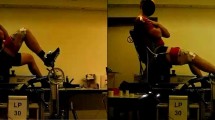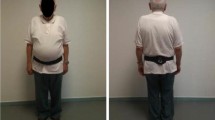Abstract
Background and aims: There is growing evidence that biological aging results in impaired force production of the lower extremities and deficits in reflex activity. This study therefore investigated maximal and explosive force production capacity, functional reflex activity (FRA) during gait perturbations, and the relationship between variables of force production capacity and FRA in young and elderly men. Methods: Twenty-eight young (age 27±3 yrs, n=14) and old (age 67±4 yrs, n=14) healthy active men were tested for decelerating impulses on a treadmill and for their maximal isometric leg extension force (MIF) and rate of force development (RFD) on a leg-press. Results: MIF and RFD were significantly lower in the elderly than in younger participants (MIF ≈45%, p<0.01; RFD ≈50%, p<0.01). Elderly subjects showed significant decreases in FRA in the prime mover which compensated for the decelerating impulse (FRA ≈29%, p<0.05). No significant correlations were found between FRA, MIF or RFD. Conclusions: Lower MIF, RFD and impaired FRA were found in old compared with young men. The absence of significant correlations between measures of strength performance and FRA may indicate that different mechanisms within the neuromuscular system are responsible for these capacities. This result may imply that force production and functional reflex activity are independent of each other and may have to be trained complementarily.
Similar content being viewed by others
References
Izquierdo M, Aguado X, Gonzalez R, Lopez JL, Häkkinen K. Maximal and explosive force production capacity and balance performance in men of different ages. Eur J Appl Physiol 1999; 79: 260–7.
Granacher U, Zahner L, Gollhofer A. Strength, power, and postural control in seniors: considerations for functional adaptations and for fall prevention. Eur J Sports Sci 2008; 8: 325–40.
Metter EJ, Lynch N, Conwit R, Lindle R, Tobin J, Hurley B. Muscle quality and age: cross-sectional and longitudinal comparisons. J Gerontol A Biol Sci Med Sci 1999; 54: B207–18.
Akima H, Kano Y, Enomoto Y et al. Muscle function in 164 men and women aged 20–84 yr. Med Sci Sports Exerc 2001; 33: 220–6.
Lynch NA, Metter EJ, Lindle RS et al. Muscle quality. I. Age-associated differences between arm and leg muscle groups. J Appl Physiol 1999; 86: 188–94.
McNeil CJ, Vandervoort AA, Rice CL. Peripheral impairments cause a progressive age-related loss of strength and velocity-dependent power in the dorsiflexors. J Appl Physiol 2007; 102: 1962–8.
Muller F, Dehail P, Bestaven E et al. Maximal and sustained isokinetic lower-limb muscle strength in hospitalized older people. Muscle Nerve 2007; 35: 739–44.
Klitgaard H, Mantoni M, Schiaffino S et al. Function, morphology and protein expression of ageing skeletal muscle: a cross-sectional study of elderly men with different training backgrounds. Acta Physiol Scand 1990; 140: 41–54.
Era P, Sainio P, Koskinen S, Haavisto P, Vaara M, Aromaa A. Postural balance in a random sample of 7,979 subjects aged 30 years and over. Gerontology 2006; 52: 204–13.
Pavol MJ, Runtz EF, Edwards BJ, Pai YC. Age influences the outcome of a slipping perturbation during initial but not repeated exposures. J Gerontol 2002; 57: M496–503.
Pijnappels M, van der Burg PJ, Reeves ND, van Dieen JH. Identification of elderly fallers by muscle strength measures. Eur J Appl Physiol 2008; 102: 585–92.
Pavol MJ, Owings TM, Foley KT, Grabiner MD. Influence of lower extremity strength of healthy older adults on the outcome of an induced trip. J Am Geriatr Soc 2002; 50: 256–62.
Granacher U, Gollhofer A, Strass D. Training induced adaptations in characteristics of postural reflexes in elderly men. Gait Posture 2006; 24: 459–66.
Frey I, Berg A, Grathwohl D, Keul J. Freiburg Questionnaire of physical activity — development, evaluation and application. Soz Praventivmed 1999; 44: 55–64.
Granacher U, Gruber M, Gollhofer A. The impact of sensorimotor training on postural control in elderly men. Deut Z Sportmed 2009; 60: 16–22.
Pijnappels M, Bobbert MF, van Dieen JH. EMG modulation in anticipation of a possible trip during walking in young and older adults. J Electromyogr Kinesiol 2006; 16: 137–43.
Gruber M, Gollhofer A. Impact of sensorimotor training on the rate of force development and neural activation. Eur J Appl Physiol 2004; 92: 98–105.
Granacher U, Gruber M, Gollhofer A. Resistance training and neuromuscular performance in seniors. Int J Sports Med 2009; 30: 652–7.
Hermens HJ, Freriks B, Merletti R et al. European recommendations for surface electromyography: results of the SENIAM project. Roessingh Research and Development bv, 1999.
Klass M, Baudry S, Duchateau J. Aging does not affect voluntary activation of the ankle dorsiflexors during isometric, concentric, and eccentric contractions. J Appl Physiol 2005; 99: 31–8.
Macaluso A, Nimmo MA, Foster JE, Cockburn M, McMillan NC, De Vito G. Contractile muscle volume and agonist-antagonist coactivation account for differences in torque between young and older women. Muscle Nerve 2002; 25: 858–63.
Narici MV, Maganaris CN, Reeves ND, Capodaglio P. Effect of aging on human muscle architecture. J Appl Physiol 2003; 95: 2229–34.
Woollacott MH, Shumway-Cook A, Nashner LM. Aging and posture control: changes in sensory organization and muscular coordination. Int J Aging Hum Dev 1986; 23: 97–114.
Lin SI, Woollacott MH. Postural muscle responses following changing balance threats in young, stable older, and unstable older adults. J Mot Behav 2002; 34: 37–44.
Tang PF, Woollacott MH. Inefficient postural responses to unexpected slips during walking in older adults. J Gerontol A Biol Sci Med Sci 1998; 53: M471–80.
Nielsen J, Kagamihara Y. The regulation of disynaptic reciprocal Ia inhibition during co-contraction of antagonistic muscles in man. J Physiol 1992; 456: 373–91.
Rothmuller C, Cafarelli E. Effect of vibration on antagonist muscle coactivation during progressive fatigue in humans. J Physiol 1995; 485: 857–64.
McCurdy K, Langford G. The relationship between maximum unilateral squat strength and balance in young adult men and women. J Sports Sci Med 2006; 5: 282–8.
Pijnappels M, Bobbert MF, van Dieen JH. Push-off reactions in recovery after tripping discriminate young subjects, older non-fallers and older fallers. Gait & Posture 2005; 21: 388–94.
Grey MJ, Ladouceur M, Andersen JB, Nielsen JB, Sinkjaer T. Group II muscle afferents probably contribute to the medium latency soleus stretch reflex during walking in humans. J Physiol 2001; 534: 925–33.
Taube W, Schubert M, Gruber M, Beck S, Faist M, Gollhofer A. Direct corticospinal pathways contribute to neuromuscular control of perturbed stance. J Appl Physiol 2006; 101: 420–9.
Bean JF, Kiely DK, Herman S et al. The relationship between leg power and physical performance in mobility-limited older people. J Am Geriatr Soc 2002; 50: 461–7.
Skelton DA, Greig CA, Davies JM, Young A. Strength, power and related functional ability of healthy people aged 65–89 years. Age Ageing 1994; 23: 371–7.
Ringsberg K, Gerdhem P, Johansson J, Obrant KJ. Is there a relationship between balance, gait performance and muscular strength in 75-year-old women? Age Ageing 1999; 28: 289–93.
Bassey EJ, Fiatarone MA, O’Neill EF, Kelly M, Evans WJ, Lipsitz LA. Leg extensor power and functional performance in very old men and women. Clin Sci 1992; 82: 321–7.
Bean JF, Leveille SG, Kiely DK, Bandinelli S, Guralnik JM, Ferrucci L. A comparison of leg power and leg strength within the InCHIANTI study: which influences mobility more? J Gerontol 2003; 58: 728–33.
Sayers SP. High-speed power training: a novel approach to resistance training in older men and women. A brief review and pilot study. J Strength Cond Res 2007; 21: 518–26.
Maki BE, Cheng KC, Mansfield A et al. Preventing falls in older adults: new interventions to promote more effective change-in-support balance reactions. J Electromyogr Kinesiol 2008; 18: 243–54.
Sakai M, Shiba Y, Sato H, Takahira N. Motor adaptations during slip-perturbed gait in older adults. J Phys Ther Sci 2008; 20: 109–15.
Maki BE, McIlroy WE. Change-in-support balance reactions in older persons: an emerging research area of clinical importance. Neurol Clin 2005; 23: 751–83.
Author information
Authors and Affiliations
Corresponding author
Additional information
This manuscript was presented as a slide show at the 55th Annual Meeting of the ACSM, Indianapolis (USA), 2008 (Granacher U, Strass D, Gollhofer A. Effect of aging on power output and functional reflex activity. Med Sci Sports Exerc 2008; 40: 87–88).
Rights and permissions
About this article
Cite this article
Granacher, U., Gruber, M. & Gollhofer, A. Force production capacity and functional reflex activity in young and elderly men. Aging Clin Exp Res 22, 374–382 (2010). https://doi.org/10.1007/BF03337733
Received:
Accepted:
Published:
Issue Date:
DOI: https://doi.org/10.1007/BF03337733




